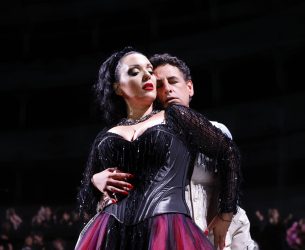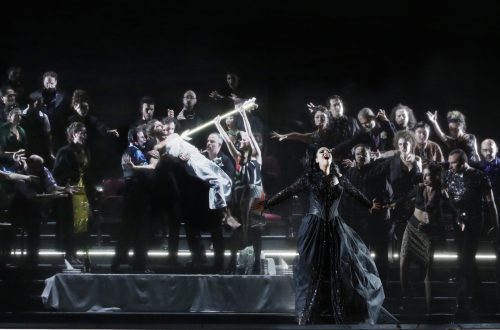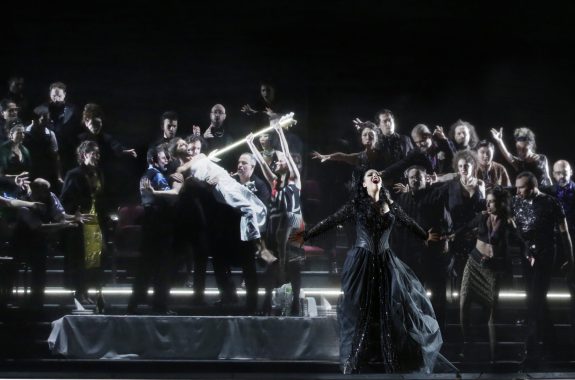
 Italy Rossini Opera Festival 2024 [2] – Rossini, Ermione: Soloists, Coro del teatro ventidio basso, Orchestra sinfonica nazionale della RAI / Michele Mariotti (conductor). Vitrifrigo Arena, Pesaro, 9.8.2024. (AB)
Italy Rossini Opera Festival 2024 [2] – Rossini, Ermione: Soloists, Coro del teatro ventidio basso, Orchestra sinfonica nazionale della RAI / Michele Mariotti (conductor). Vitrifrigo Arena, Pesaro, 9.8.2024. (AB)

Production:
Director – Johannes Erath
Set designs – Heike Scheele
Costumes – Jorge Jara
Video – Bibi Abel
Lighting – Fabio Antoci
Chorus director – Giovanni Farina
Cast:
Ermione – Anastasia Bartoli
Andromaca – Victoria Yarovaya
Pirro – Enea Scala
Oreste – Juan Diego Flórez
Pilade – Antonio Mandrillo
Fenicio – Michael Mofidian
Cleone – Martiniana Antonie
Cefisa – Paola Leguizamón
Attalo – Tianxuefei Sun
Ermione almost has a mythical reputation among Rossini enthusiasts, and it was certainly the most anticipated new production of the 2024 Rossini Opera Festival. This opera, long considered Rossini’s dark horse, has undergone a remarkable reappraisal worldwide since its revival here in 1987 and a second production in 2008. Though audiences at its 1819 premiere were puzzled by the work’s bleakness, unorthodox structure, and mode of composition – a notion Rossini himself later encouraged – today, we recognise it as a masterpiece of brooding intensity.
Ermione is a cauldron of Greek tragedy, its plot brimming with passions and primal drives, all unfolding in a post-Trojan War setting where desire, unrequired love and vengeance collide. Pirro, son of Achilles and King of Epirus, who should be marrying Ermione, daughter of Menelaus, is instead fixated on the captive Andromaca. As Hector’s grieving widow, she is indifferent to his advances and driven solely by love for her child, Astianatte. Ermione, in a fit of jealous rage, manipulates Orestes – the King of Greece’s envoy, who is in love with her – into murdering Pirro, only to unravel completely and take her own life once the deed is done.
The historical footnotes are well-known: Ermione was a flop at its Naples premiere in 1819, largely because it defies many of the conventions of opera seria with its unrelenting bleakness and atypical dramatic structure. Its tragic ending – something Rossini’s librettist Andrea Leone Tottola wisely preserved from Jean Racine’s Andromaque, which echoes Euripides’s Medea and Sophocles’s Ajax – set it apart from the more conventional lieto fine that contemporary Neapolitan audiences expected.

It is precisely this darkness that Johannes Erath’s production embraces, cloaking it in all-black sets, ominous lighting, and video projections that push theatrical opulence to the brink of excess. Heike Scheele’s towering set, with its three concentric, neon-lit frames connected by wide stairs, creates a vast stage that often threatens to swallow the singers.
The decision to stage key duets, such as the Act I confrontation between Pirro and Ermione, across the immense 20-metre divide of the proscenium, while visually striking, does little to convey the seething emotions at play. One might admire the ambition, but intimacy and subtlety – key to the opera’s psychological depth – are often sacrificed.
The chorus (the once more excellent Coro del Teatro Ventidio Basso under Giovanni Farina’s direction), clad in black leather and lurking like a decadent and degenerate collective, delivers spine-chilling menace. Their wave-like movements eerily echo the Furies who will pursue Orestes after the end of the opera. However, additional video projections – including inexplicable footage of the Teatro Rossini’s interior – and an almost hyperactive lighting design leaves the audience grappling with sensory overload. Even Amor, personified and prancing across the stage with glowing arrows, seemed a symbolic flourish too far, pushing the production into the realm of the overwhelming.
It is left to Michele Mariotti and the Orchestra Sinfonica Nazionale della RAI to reclaim the opera’s subtler virtues. Mariotti uncovered the extraordinary fine details in Rossini’s score, achieving balance despite the acoustic challenges of the cavernous Vitrifrigo Arena. The orchestra’s playing was electric and alive to every nuance, lending the performance a gravitas that was often eclipsed on stage.
Vocally, the cast excelled. Anastasia Bartoli’s Ermione was a whirlwind of conflicting emotions — fury, sensuality, regret, and madness — all channelled through a voice rich in colour and capable of effortless shifts between gentle love, despair, and sardonic bite. If only the staging had allowed for closer, more intimate moments where her artistry could have truly shone.
Enea Scala’s Pirro matched Bartoli’s intensity, tackling the demands of agility, tonal leaps, cadenzas, and high notes with electrifying boldness and precision, delivering a performance both imposing and lyrical. Victoria Yarovaya offered a serene, dignified portrayal of Andromaca with precise coloratura and careful phrasing, giving the character’s emotional reserve an understated poignancy.
The evening’s special focus inevitably fell on Juan Diego Flórez, the ROF’s artistic director, making his Pesaro stage debut as Orestes. This is no easy role — vocally demanding and dramatically intense — but Flórez, now a seasoned veteran, approached it with remarkable skill. His impeccable phrasing and effortless high notes remain a joy, and his ability to convey Orestes’s torment was both vocally and dramatically convincing.
Both Michael Mofidian as Fenicio, with his beautiful voice and charismatic stage presence, and Antonio Mandrillo as Pilade, with his clear yet penetrating timbre, stood out. So did ballet dancer Ian Gualdani who gave an impressive performance as the Andromaca’s son Astianatte, who is beaten, tortured and abused by Fenicio and his fellow Epirotes.
This Ermione was a bold, visually lavish production that certainly made a statement. Yet, in its ambition to depict a decaying world of fury and unrequited love, it occasionally lost sight of the opera’s subtle and intimate dimensions. There was much to admire, not least in the performances and Mariotti’s musical leadership, but one couldn’t help but feel that in nearly overwhelming the audience with spectacle, the true emotional core of Rossini’s masterpiece remained somewhat out of reach.
Andreas Bücker
